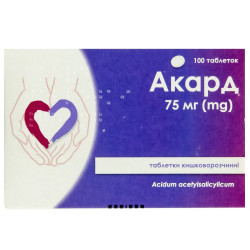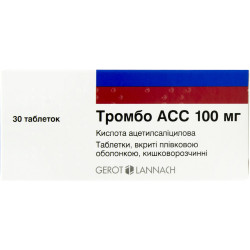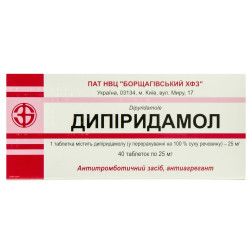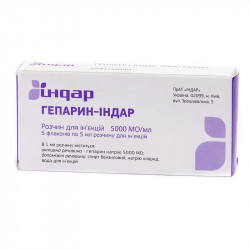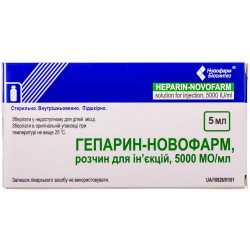



- Stock: In Stock
- Model: 179239
0% Customers recommend this product
-
5 Awesome0%
-
4 Great0%
-
3 Average0%
-
2 Bad0%
-
1 Poor0%
Reviews Over Geparin-Pharmex solution for infection. 5000 ME/ml fl. 5 ml No. 5
- (0)
Total Reviews (0)
click here write review to add review for this product.
Report this review.
Description
Structure and form of release
Structure
Active ingredient: 1 ml of solution contains heparin sodium 5000 ME;
excipients: benzyl alcohol, sodium chloride, water for injections.
a release Form
Solution for injections.
Pharmacological properties
Pharmacodynamics.
Heparin is glikozaminglikany (mucopolysaccharide) which consists of the sulphated remains of a D-glycosamine and D-glucuronic acid.
Heparin - anticoagulant of direct action. In solution heparin has a negative charge that promotes its interaction with squirrels who participate in fibrillation process. Heparin contacts antithrombin III (heparin cofactor) and inhibits process of fibrillation by an inactivation of factors of V, VII, IX, X. At the same time the factors activating fibrillation (kallikrein, IXa, Xa, XIa, XIIa) are neutralized, transition of a prothrombin to thrombin is broken. When process of a tromboorazovaniye already began, a large amount of heparin can slow down further coagulation by an inactivation of thrombin and slowing down of transformation of fibrinogen into fibrin. Heparin also prevents formation of stable fibrinous clots by slowing down of activation of a fibrinstabiliziruyushchy factor. At parenteral administration, heparin slows down fibrillation, activates process of a fibrinolysis, the activity of some enzymes (hyaluronidase, phosphatase, trypsin) oppresses, slowing down the effect of prostacyclin on aggregation of platelets caused by effect of adenosinediphosphate.
Pharmacokinetics.
maximum level in blood plasma is reached byAfter intravenous administration in a few minutes, after slow intravenous infusion - not later than in 2–3 min., after hypodermic introduction — in 40–60 min. The volume of distribution of heparin corresponds to the volume of blood plasma and substantially increases at increase in a dose of medicine. Proteins of blood plasma at concentration of ME/ml heparin 2 of blood connect up to 95% of medicine, at higher concentrations — it is less. Heparin is partially metabolized in a liver. About 20% are defined in urine in the form of not changed heparin and uroheparin (has activity of 50% of active agent). The period of biological half-decay is 1.32-1.72 hours. Plasma elimination half-life of blood makes 30–60 min. In a liver failure heparin kumulirutsya. Heparin does not get into breast milk, badly gets through a placenta.
Indication
Prevention and treatment of thromboembolic diseases and their complications (a sharp coronary syndrome, fibrinferments and embolisms of the main veins and arteries, vessels of a brain, an eye, i a phase of a syndrome of disseminate intravascular coagulation, a constant form of atrial fibrillation with embolization); for prevention of postoperative venous thromboses and embolisms of a pulmonary artery (in the mode of low dosing) at the patients who transferred surgical interventions or at those who for any other reasons have risk of developing a clotting disease; for prevention of fibrillation at laboratory researches, dialysis, extracorporal blood circulation, heart surgeries and vessels, direct blood transfusion.
Contraindication
Hypersensitivity to heparin and/or benzyl alcohol; hemophilia; hemorrhagic diathesis; suspicion of geparinindutsirovanny immune thrombocytopenia; round ulcer of a stomach and duodenum; heavy arterial hypertension; cirrhosis which is followed by a gullet varicosity; heavy renal and liver failure; bacterial endocarditis; periods; recently carried out surgical interventions, especially neurosurgical and ophthalmologic; ulcer colitis; malignant new growths; hemorrhagic stroke (first 2–3 days); cherepnomozgovy injuries; retinopathy; hemorrhage in eye tissue; destructive pulmonary tuberculosis; entsefalomalyation; hemorrhagic pancreatonecrosis; bleedings of any localization (open stomach ulcer, intracranial bleeding), except for the hemorrhage which arose because of an embolic heart attack of lungs (pneumorrhagia) or kidneys (hamaturia); repeated bleedings in the anamnesis, irrespective of localization; increase in permeability of vessels (for example at a disease of a verlgof); state of shock; abortion threat.
Heparin cannot be applied: to patients who used high doses of alcohol; in the form of intramuscular injections; at sharp and chronic leukoses; aplastic and hypoplastic anemias; at sharp aneurysm of heart and aorta; during operations on a head or spinal cord, an eyeball, ears; after carrying out surgeries on sites where development of bleeding is life-threatening the patient; at diabetes; when carrying out epidural anesthesia during childbirth. Conduction anesthesia as use of heparin in rare instances can cause epidural or spinal hematomas is contraindicated to patients to whom apply heparin with the medical purpose when carrying out planned surgeries therefore long or irreversible paralysis can develop.
Interaction
Anticoagulants of direct and indirect action strengthen effect of heparin. antihistaminic medicines and medicines of a digitalis, tetracyclines, nicotine, nitroglycerine, corticotropin, thyroxine weaken anticoagulating effect of medicine. the means reducing aggregation of platelets (acetylsalicylic acid, a dextrin, phenylbutazone, an ibuprofen, a metindol, Dipiridamolum, hydroxychloroquine, fibrinolitik, ascorbic acid, ergot alkaloids, indometacin, Sulfinpyrazonum, probenetsid, cephalosporins, ketorolak, epoprostinol, klopidogrel, tiklopidin, streptokinase, intravenous administration of penicillin, Acidum etacrynicum, tsitostatik), at simultaneous therapy with heparin can cause hemorrhages therefore they need to be applied very carefully. the risk of hemorrhages also increases at combination therapy of heparin with ulcerogenic, immunosuppressive and thrombolytic medicines.
Heparin can force out Phenytoinum, quinidine, propranolol, benzodiazepines and bilirubin from places of linking with proteins of blood plasma. At simultaneous application alkaline medicines, enaprilat, tricyclic antidepressants can contact heparin that leads to mutual decrease in efficiency.
APF Inhibitors, antagonists of angiotensin ІІ: development of a hyperpotassemia is possible.
Alcohol: simultaneous consumption of alcoholic drinks considerably increases risk of developing bleedings.
Feature of application
When prescribing heparin with the medical purpose is forbidden to administer the medicament intramusculary. it is necessary to avoid biopsies, epidural anesteziya and diagnostic lumbar punctures.
to applyWith care to patients at whom reactions of hypersensitivity to low-molecular heparins were noted earlier.
Quantity of platelets should be determined bybefore an initiation of treatment, in the first day of treatment and in 3-4 days throughout the entire period of prescribing of heparin. Sudden decrease in quantity of platelets demands immediate medicament withdrawal and also a further research for the purpose of specification of an etiology of thrombocytopenia. At suspicion of geparinindutsirovanny thrombocytopenia like the I or II treatment by heparin it is necessary to stop.
Upon transition from therapy by heparin on intake of indirect anticoagulants heparin can be cancelled only when indirect anticoagulants provide increase in a prothrombin time up to therapeutic borders not less than 2 days in a row.
for the purpose of avoidance of considerable hypocoagulation needs to reduce a heparin dose, without increasing intervals between injections.
during use of heparin is recommended to control hematologic indicators and also to watch a clinical condition of the patient, features of development of hemorrhagic complications.
At patients 60 years are more senior thanheparin can cause hemorrhages, especially in women and in patients with a renal failure.
Patients sensitive to proteins of animal origin can be sensitive and to heparin.
At suspicion on reaction of hypersensitivity several minutes prior to introduction of a full dose should enter slowly intravenously a divorced trial dose 1000 ME.
should adhere toExtra care within 36 hours after the delivery.
At patients with arterial hypertension should control arterial blood pressure.
or those who use potassium medicaments during use of medicine recommends to controlAt patients with diabetes, the renal failure, a metabolic acidosis raised by potassium concentration in blood constantly potassium level in blood, in view of the increased danger of development of a hyperpotassemia.
Use during pregnancy or feeding by a breast toHeparin is not contraindicated to
at pregnancy. medicine does not get through a placenta. though heparin does not get into breast milk, appointment to his nursing mothers in some cases caused fast (within 2–4 weeks) development of osteoporosis and injury of a backbone. the expediency of use of medicine is defined individually taking into account a ratio advantage for mother/risk for a fruit. Ability to influence speed of response at control of motor transport or other mechanisms.
do not have
data on influence of heparin on speed of response at control of motor transport or work with other mechanisms.
Route of administration and doses appointGeparin-pharmex by
in the form of jet or faltering intravenous or subcutaneous injections. before prescribing of medicine it is necessary to define a blood clotting time, the thrombin and activated partial tromboplastinovy time, quantity of platelets. for cultivation of heparin use only 0.9% chloride sodium solution. with
Adult at sharp thrombosis treatment there begin with intravenous administration 10000-15000 ME
Geparina-Pharmex, controlling coagulation of venous blood, the thrombin and activated partial tromboplastinovy time. After that on 5000-10000 ME Geparina-Pharmex enter intravenously each 4-6 hours. At the same time the dose of Geparina-Pharmex at which the blood clotting time is extended by 2.5-3 times, and the activated partial tromboplastinovy time - by 1.5-2 times is considered adequate.
For prevention of sharp thrombosis of Geparin-Pharmex is entered subcutaneously for 5000 ME each 6–8 hours. At the first phase of a syndrome of disseminate intravascular fibrillation (DVS) at adults heparin apply subcutaneously a long time in a daily dose 2500-5000 ME with control of thrombin time. In 1-2 days prior to cancellation of Geparina-Pharmex the daily dose is gradually reduced.
during open-heart surgery with connection of the device of extracorporal blood circulation to patients Geparin-Pharmex in an initial dose enter not less than 150 ME on 1 kg of body weight. If the procedure continues less than 60 minutes, appoint a dose of 300 ME/kg and if the procedure continues more than 60 minutes, appoint 400 ME/kg.
With the preventive purpose of Geparin-Pharmex is entered subcutaneously in a dose 5000 ME in 2 hours prior to operation, then for 5000 ME each 6-8 hours within 7 days.
As addition to Geparin-Pharmex streptokinase on 5000 ME 3 times a day or 10000-12500 ME 2 times a day is shown at the increased risk of development of thrombolytic complications at patients:
- at a repeated myocardial infarction;
- with a constant form of atrial fibrillation with embolization.
At a sharp coronary syndrome (unstable stenocardia or a myocardial infarction) at first are struyno intravenously entered by 5000 ME Geparina-Pharmex, then pass to intravenous drop administration of medicine with a speed of 1000 ME/hour. Speed of infusion needs to be selected so that within the first 2–3 days to support the activated partial tromboplastinovy time at the level of 1.5-2 times it is more, than its normal value.
to Children of Geparin-Pharmex is appointed according to such scheme: the initial dose makes 50 ME/kg (intravenous injection / infusion), a maintenance dose - to 100 ME/kg there are each 4 hours. The average daily dose for children makes 300 ME/kg.
to Babies are appointed by from 2 to 10 ME/kg/h intravenously (constantly or falteringly). Subcutaneously to babies heparin is entered in a daily dose of 200-300 ME/kg, distributing it on 4–6 injections.
In all cases at application of Geparina-Pharmex in 1-3 days prior to its cancellation are appointed by indirect anticoagulants.
Children. To children of a dose appoint according to the mass of their body. do not apply to premature children and newborns. development of allergic reactions, including toxic, at children up to 3 years is possible.
OverdoseAt overdose the developing of bleedings is possible
. at insignificant bleedings is sufficient to reduce a dose of medicine or to temporarily stop its introduction. at considerable bleedings it is necessary to cancel urgently introduction of heparin and to appoint antidote - 1% sulfate protamin solution (to enter slowly intravenously) from calculation that 1 mg of protamin of sulfate neutralizes 85 me heparin. Side reactions
belong To the most widespread side reactions hemorrhages, increase in level of liver enzymes, reversible thrombocytopenia and various dermatological violations. also it was reported about isolated cases of generalizirovanny allergic reactions, necrosis of skin and a priapism.
- from the system of blood: thrombocytopenia of I and II type, epidural and spinal hematomas.
- from mentality: depression.
- from nervous system: headache.
- from a digestive tract: nausea, vomiting, diarrhea.
- from a gepatobiliarny system: increase in level of hepatic Transaminases (ALT and nuclear heating plant), lactate dehydrogenases, gamma glutamiltransferazy and a lipidemia (these violations are reversible and disappear at medicament withdrawal).
- from skin and hypodermic cellulose: rashes (erythematic, makulopapulezny), urticaria, an itch, an itch and burning in skin of feet, skin necrosis, a multiformny erythema, an alopecia.
- from a musculoskeletal system: osteoporosis, demineralization of bones.
- from a reproductive system: priapism.
- from the immune system: skin rashes, conjunctivitis, dacryagogue, rhinitis, a bronchospasm, asthma, the Tachypnea, cyanosis, an allergic vasomotor spasm in extremities, anaphylactoid reactions, an acute anaphylaxis.
- from an endocrine system and metabolism: a hypoaldosteronism, a hyperpotassemia, increase in level of thyroxine, decrease in level of cholesterol, increase in level of glucose in blood.
- from a cardiovascular system: hemorrhages and hematomas in any body or the system of bodies (hypodermic, intramuscular, intraperitoneal, nasal, intra intestinal, gastric, uterine).
- Reaction in the injection site: irritation, ulcers, morbidity, hemorrhages, hematomas and an atrophy in the place of an injection.
- Other: cold, fever.
Thrombocytopenia as a therapy complication heparin occurs in 6% of patients. It can arise as a direct consequence of aggregation of platelets under the influence of heparin or owing to an immune response when the antibody strikes platelets and an endothelium. Reactions of the first type, as a rule, are shown benign and disappear after the therapy termination, and reactions of the second type have difficult character. Owing to thrombocytopenia there can be necroses of skin and fibrinferment in arteries ("white blood clot") which are followed by a recurrence of venous tromboemboliya, development of gangrene, myocardial infarction, stroke. At appearance of heavy thrombocytopenia (decrease in quantity of platelets twice from initial quantity) it is necessary to stop use of heparin. Increase in activity transminaz (ALT and nuclear heating plant), levels of free fatty acids and thyroxine can be observed; reversible delay of potassium.
Storage conditionsto Store
out of children's reach. To store in original packing at a temperature not above 25 °C. An expiration date - 2 years.
Specifications
| Characteristics | |
| Active ingredients | Heparin |
| Amount of active ingredient | 5000 PIECES/ml |
| Applicant | Pharmex Group |
| Code of automatic telephone exchange | B01AB01 Heparin |
| Interaction with food | It doesn't matter |
| Light sensitivity | Not sensitive |
| Market status | Generic-generic |
| Origin | Biological |
| Prescription status | According to the prescription |
| Primary packing | bottle |
| Producer | LTD COMPANY PHARMEX GROUP |
| Quantity in packing | 5 bottles on 5 ml |
| Release form | solution for injections |
| Route of administration | Intravenous |
| Sign | Domestic |
| Storage temperature | from 5 °C to 25 °C |
| Trade name | Heparin |












